Video Game Reflections
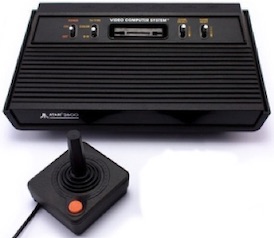
The Atari days
When it came to video games growing up, my parents were fairly progressive – although they had no desire to play them, they didn’t see them as anything but fun and somewhat educational. And in the early 80s, when home game consoles were all the rage, my parents bought us an Atari 2600 (the all-black “Darth Vader” model shown to the right) and some games.
We lived in a big old house, and there was a very large, unused room upstairs (we affectionately called “the back room”) that was used as the toy/Atari room. My sister was a few years younger than I was, and didn’t have much interest in the Atari, so I was the one that played it the most. I remember playing Berzerk on the Atari 2600 until I couldn’t keep my eyes open anymore.
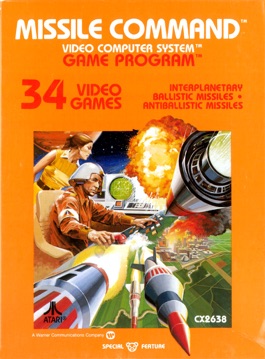
Although I didn’t know it at the time, the whole home console video game industry crashed in 1983 due to market saturation, and the price of Atari 2600 games took a nosedive.
That meant that our mom occasionally bought a new Atari 2600 game whenever we went to the places like K-Mart. I remember convincing mom to buy Missile Command because it was cheap and the cover advertised that it had 34 games (even though it was just 34 different variations or “difficulty levels” of the same game) – and it quickly became my favorite game. I also convinced mom to buy the E.T. game for the Atari, because it was only $1.99! Too bad the game was horrible.
You win some, you lose some, I guess.
There is always one kid in every neighbourhood who has more games than anyone else – and in our neighbourhood, that kid was Eric. Eric’s parents had recently divorced, and although he lived with his father and older brother in a big house, his father was rarely around (he was a famous wildlife photographer). But it didn’t matter too much because Eric had the biggest Atari 2600 game collection of anyone I knew – he had all of the games I had plus a ton of games that I didn’t have (Star Raiders, Asteroids, Demon Attack, Stargate, Pac-man, Pitfall, Space Invaders, and so on). I used to go over to his place and play Atari 2600 games for hours in his rec room, as well as watch the odd Dr. Who episode (his father was a big Dr. Who fan).
Luckily, the home console video game industry crash of 1983 didn’t prevent new games from being released for the Atari 2600, so everyone I knew who had an Atari 2600 continued to play it for several years afterwards. Atari even released a slim/inexpensive version of the Atari 2600 in 1986 because the sheer number of Atari 2600 games kept the console in high demand throughout the mid-80s as well! Other home consoles weren’t so lucky – in fact, nearly all other home consoles (including the ColecoVision and Intellivision) disappeared shortly after the crash, leaving Atari as the only player in the market. Atari brought out a more advanced console called the Atari 7800 in 1984, but very few people bought it because there were far fewer games for it compared to the Atari 2600.
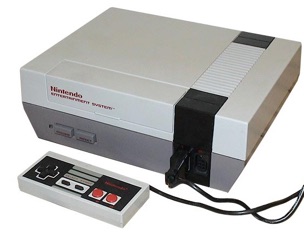
Enter the NES
In the late 80s, we got the famous Nintendo Entertainment System (NES) for Christmas with Duck Hunt (and light gun) as well as Super Mario Bros.
It was incredible! The NES had amazing graphics and sound compared to the Atari 2600, and our Atari 2600 was almost immediately forgotten. Several years later, when I powered up the Atari 2600 again, it was completely dead - it was almost as if it committed Seppuku when the NES arrived.
The NES was a great console, but my sister liked it almost as much as I did, and since it was both of ours, there were times I had to begrudgingly let her play it too. That being said, I probably spent as much time (if not more) playing the NES compared to the Atari 2600. After completing Super Mario Bros, I had to get Super Mario Bros 2. And after I finished that, I moved onto Super Mario Bros 3. I still remember the feeling of accomplishment I had after completing the final Super Mario game! After that, I focused on The Legend of Zelda, which I enjoyed just as much. I didn’t have any other games for the NES, but I certainly didn’t need need any.
PC gaming
While NES video games were a mentally satisfying escape, they still required a fair amount of time (but still FAR less than console games of today). And when I reached middle school (Grade 7/8), my interests started shifting to more academic ones. I had less time to play video games, and little-to-no interest in some of the newer game consoles that friends of mine were playing (Sega Genesis, TurboGrafix-16 and Super NES). By high school, I rarely played a game console.
I didn’t stop enjoying video games, however – I just shifted from playing console games to playing computer games. I’m not surprised– after all, I was HEAVILY into computers during the 80s and 90s:
-
Back in 1982, my grade school (Centennial Public) got a bunch of Commodore 64 computers on movable desks that could be wheeled to any classroom in the school. We also had four Apple II computers in the school library that could be used any time of the day. I took to computing with vigor – I was the only kid in the school who could write programs on the machines (something that impressed the hell out of all of my teachers and earmarked me for a wide range of opportunities, including the coveted “Film Club” where we learned how to animate on acetate film as well as on computers).
-
In the late 80s, my parents bought the family a used Commodore 128 (which essentially became “my” computer). Later on I cashed in a $1000 savings bond that my grandparents gave me to help buy a Twinhead Superset 590 from Radio Shack, which boasted an Intel 80386SX (20MHz) CPU with 1MB of RAM (later upgraded to 4MB) and a whopping 100MB hard drive. I also bought a 2400 baud modem and scoured the online Bulletin Board Systems (BBSes) for loads of information on computer programming, as well as free copies of games! In case you were wondering what one of these ancient computers looked like, here is a flyer I found on the Internet of my old Twinhead PC:
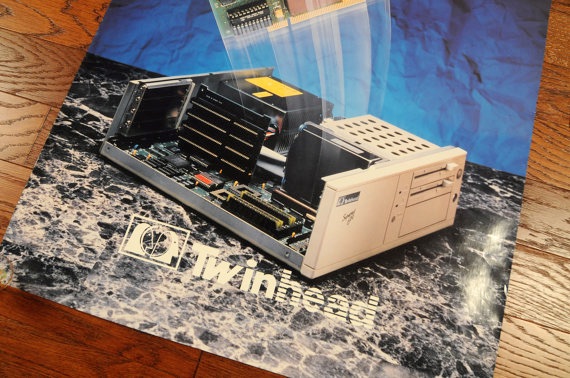
- While our high school mostly had IBM PCs running DOS, we also had a lab full of UNIX machines (ICON computers running QNX), and the source code for most programs were stored on the unprotected LexICON file server in the classroom. I learned how to program in C, and then recompiled a lot of the software in the classroom to pull pranks (one of the drawing programs I modified swore at you randomly ;-). Because I was an A+ student, my school decided to put me in enrichment and eventually the Advanced Placement program (which allowed me to attend university classes when I was in high school) – I ended up becoming a staff programmer for the University of Waterloo School of Accounting while I was in high school, and the rest is history!
Games on the Commodore 128 weren’t that great compared to the NES, but games on a modern PC computer blew them out of the water! So my free time involved playing PC games on my trusty Twinhead 80386:
-
In 1990/1991 I played the whole Commander Keen series. [I should note that I also played a lot of the Where in the World is Carmen Sandiego? series on the Mac II computers in my high school homeroom at the time]
-
1992 brought Wolfenstein 3D, more Wolfenstein 3D, and even more Wolfenstein 3D after that. The picture to the right may seem primitive by today’s standards, but back in 1992, those 3D graphics were nothing short of revolutionary!
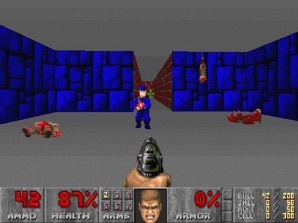
- 1993 was the year I bought a CD-ROM and played the amazing LucasArts games Day of the Tentacle and Sam & Max Hit the Road, as well as the infamous sequel to Wolfenstein called DOOM!
After 1993, I never really played PC games very much. The only exception to that were the Quake III Arena LAN parties we had after class at the triOS College Kitchener campus back in 2000. Quake III Arena was one of the successors to DOOM, and could be played across the network with others – it was a lot of fun, and I remember playing it at home on the Pentium II computer I had built for myself.
The PC games released after 2000 didn’t appeal to me much. Most required that you play online with others, and also involved a large amount of time (which I didn’t have). However, by that time my daughter was in Kindergarten and the perfect age for educational games, so I ended up hunting for some good games that she would enjoy. Most educational games at the time were made for Mac computers, so I eventually bought her an eMac and a few really good games that she loved to play. The one she played the most was Dinosaur Adventure 3D, where you had to find “hatching crystals” while learning about dinosaurs in order to save the dinosaurs from a volcanic eruption (the back cover is shown below). The other one she played a lot of was Uncle Albert’s Magical Album – a game full of mini obstacles and a cool story. I consider both of these games great for kids today too!
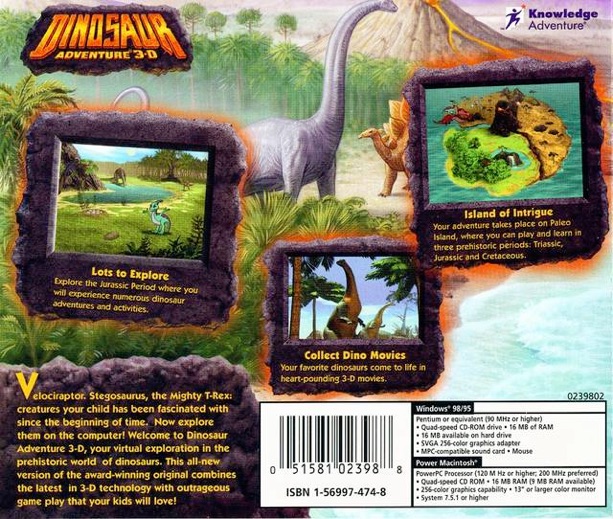
Enter the Xbox, Wii and NDS
When the Xbox was released in 2001, it was considered a revolutionary thing in the gaming world – it was essentially a full PC running DirectX in a console, and it came with the most revolutionary game released up until that time: Halo. As a reward for working on a new project, a fellow workmate and myself got a free Xbox…. and Halo.
Halo was everything you wanted a game to be – you played a character in an immersive story with incredible 3D graphics (see below) and a movie-like soundtrack. My friend Matt and I completed the whole game in 11 hours one evening. Well…. not exactly. We completed 10 hours in one evening but couldn’t get past the last level. So Matt went home. But neither of us could sleep (the music from the game was constantly playing in our heads), so he came over early the next day and we finished the last level in an hour. It was the best game we played up until that time!
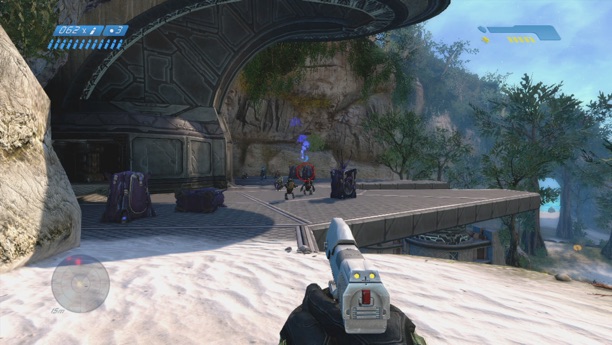
Because of the Halo experience, I ended up getting other awesome games for the Xbox (Splinter Cell, Kakuto Chojin, Halo 2) and spent a good chunk of my free time on weekends in the early 2000s playing them! When the Xbox 360 came out, I had to buy it just to play Halo 3. But I lost interest in console gaming after that. Luckily, my daughter used the Xbox 360 to play Guitar Hero. When the Xbox 360 overheated and burned out for the third time, we sold our canoe and bought a Nintendo Wii so that she could continue playing Guitar Hero. Nintendo was doing some cool things at the time, and so I also bought her a Nintendo DS (NDS) Lite and added a ton of games to it via an R4 card that allowed you to play several games from one card. The NDS Lite was a great gaming device – my daughter played it so much that she actually wore out the hinge between the two screens. Luckily, Nintendo has amazing customer service, and a few days later they shipped a replacement to the house.
Wait…. What about Arcade games?
I couldn’t slip in arcade games earlier because they spanned my entire gaming life ;-)
When I was growing up in the 80s, arcade games were these massive and beautiful behemoths that showcased the bleeding edge of technology (the 80s was chalked full of technological optimism). They were also quite expensive for the time - if you managed to get a few quarters from your parents, you could spend them at your local convenience store on candy, chips, pop or popsicles…….. or you could play a few games at 25 cents each that may only last a few minutes (or sometimes seconds) in total. If you didn’t have a lot of funds or rich parents, you usually chose the former.
What did this mean for me? It meant that I didn’t initially pump a lot of quarters into arcade machines…. until later on (we’ll get to that in a few paragraphs).
The first arcade game I remember was a Space Invaders outside the K-Mart in the John Galt Mall in my hometown of Cambridge. There were also one or two arcades in the Becker’s convenience store at the end of our street – rotated at various times, but never great ones (Bagman, Wizard of Wor, Satan’s Hollow, and others I don’t remember).
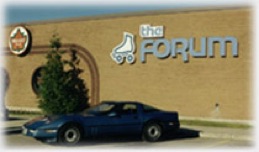
I also remember playing arcade games at “The Forum” roller rink in my Cambridge home town when we went there on school trips (I couldn’t roller-skate well, so it was a welcome escape for the few hours we were there each time).
The Forum had a LOT of arcade machines, including some great classics: Pole Position, Centipede, Pac-man, Ms. Pac-man, Super Pac-man, Galaga, Missile Command, Time Pilot and Arkanoid.
The best arcade experiences of my childhood came from an arcade that opened in the Pinto plaza around the corner from where I lived (it used to be where the red arrow is in the picture below).
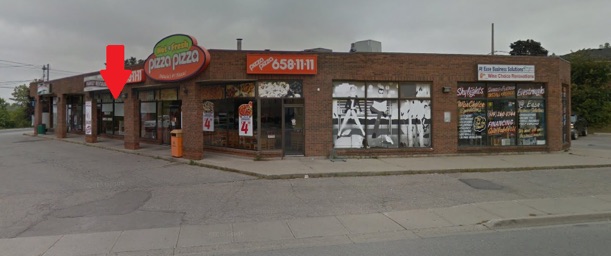
It had all the money-making classics (Pac-man, Ms. Pac-man, Galaga, Bosconian, Tempest, Asteroids, Centipede, Millipede, Zaxxon, Missile Command), and was fairly busy most of the time. About this time, I got my first (and only) paper route delivering the Cambridge Pennisaver (a free newspaper that was mostly classified ads). I hated delivering newspapers, so I quickly figured out that I could simply go to the end of my street, dump the papers in an overgrown field next to the Becker’s convenience store, and spend my hard earned money at the arcade for an hour before returning home (my parents none-the-wiser since I was gone for so long). The problem was that the small amount of money you make delivering newspapers doesn’t give you an hour of gameplay in an arcade when the average game only lasts a few minutes or less (if you are good!). So I watched other people playing and learned their strategies inside and out before sinking a quarter into a machine. I got really good really fast with this strategy, so I started making bets with other kids that I could beat their scores. It was pure hustling, and I was good at it. Plus, Eric’s older brother and his friend (who were both considered “badasses” at the time) helped me set up my bets with new visitors. They never ever asked for anything in return (I got the impression that Eric’s older brother just got a kick out of watching me hustle people).
But nothing lasts forever. Although it took the newspaper company several months to figure out that I wasn’t delivering the newspaper, they eventually did. When they called my mom, I politely quit the job since I could easily hustle quarters by that time anyways. Unfortunately, the arcade closed a few months after that and my arcade gaming was limited to the occasional game we found (on days that I had at least one quarter I was willing to spend). But then came Shelter Valley……
When I was growing up, my parents took us camping for a few weeks each year to provincial parks in Ontario (mostly Arrowhead, The Pinery, and Killbear), but as we got older, my parents bought a much larger trailer (a 24-foot Mallard) and realized that it would be far better to park our trailer at a campground that we could visit each weekend. They picked an amazing recreation campground called Shelter Valley near Goderich, Ontario. We were there almost every weekend during late spring to early fall, as well as for several weeks during summer vacation. Shelter Valley was a very family-oriented campground – it had a playground, in-ground pool, regular community pig roasts, and a building that housed both a convenience store and large recreation centre (the pic shown below is the convenience store entrance - the rec centre is the much bigger part that extends past the golf cart in the picture).
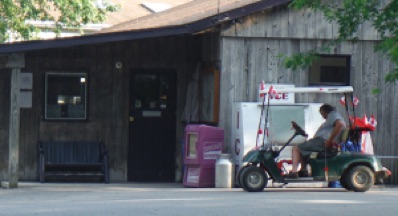
The very large barn-style doors on the two sides of the recreation center were always open and allowed the breeze to waft through, so it felt more like an outdoor canopy than an indoor place. People would often come in just to get some shade. There were 3 ping-pong tables in the middle, as well as 2 pinball machines and a Shinobi arcade machine along the wall (they later got an NBA Jam arcade machine as well, but it was rarely played). I wasn’t very good at ping-pong or pinball, so I spent a massive amount of time on the Shinobi arcade, and before long I was incredibly good at the game. Newcomers, and short-term campers would come to the park, bringing kids my age, but none of them could beat me at that game, and I made sure that they knew it (yes, I was a bit of a pompous prick, but at least I put my hustling days behind me by that time ;-). I also remember the sunny afternoon that I managed to get to the final boss in Shinobi. I defeated him on my first attempt, which surprised me because he jumped around a lot and was hard to hit. It was a great feeling – a real sense of achievement since it was the first arcade game I’ve ever completed (early arcade games typically had no ending whatsoever…. they just got harder and harder until you died). Unfortunately, having completed the game, I had no desire to play it again, but I occasionally enjoyed watching other people play it.
The last arcade game I remember playing was during a trip to Pioneer SportsWorld in 1991. SportsWorld was an amazing fun park in Kitchener, Ontario that had the largest arcade I’ve ever laid my eyes on (the entrance to it below doesn’t do it justice…..it was massive inside):
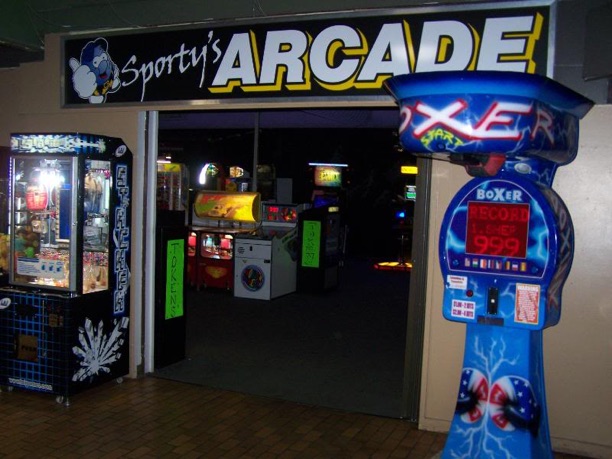
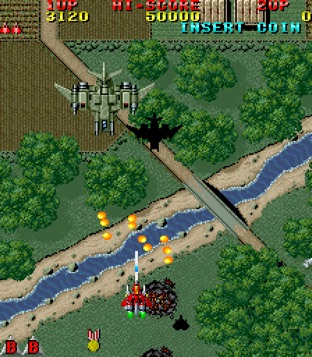
On a trip there with my friend Matt, we stopped to play a few arcade games – the new massive sit-down SEGA arcade games that Matt liked didn’t interest me too much, so I settled for playing a cool new Galaga-like shooter called RAIDEN that had a massive 25” screen (most arcade games had a 19” screen).
RAIDEN had this incredibly smooth/advanced gameplay and graphics for the time, and my first impression was something along the lines of “Whoa – games are getting pretty advanced!” I sunk in all the money I brought with me into that machine (leaving me broke for the rest of the day). It was the last arcade game I played until 2012.
In January 2012, I got this crazy idea to look up arcade machines on the Kijiji classifieds website and came across an ad for a full-sized RAIDEN arcade game about 40 minutes away for $250. I talked the owner down $50 and picked it up with my daughter at 10pm (we didn’t get the machine into the basement until after midnight). Suddenly I had an awesome arcade machine that I could play without having to pump in quarters! Suffice to say, I got really good at RAIDEN in a short period of time, and the arcade collecting bug hit me.
Then the very next year, my workplace decided to be the major sponsor for the world’s largest video game exhibition (Game ON 2.0) when it came to Canada for the first time. It was held at the Ontario Science Centre for 6 months in 2013 and I had a very large role in designing our game development part of the exhibition and promoting it via social media – I even gave regular talks and seminars, including one where I would show a theatre full of kids and parents how to create Galaga with programming using my Alienware laptop connected to the theatre projector.
I was in my element for sure, and my passion for retro games went through the roof – especially since Game ON 2.0 had a LOT of arcade machines that I didn’t have at the time, such as Missile Command, Asteroids, Pac-man and Donkey Kong (I’ve since added all of these arcade games to my own collection).
During WWII, my grandmother always wanted stylish clothes but could never afford them. So later on in life when my grandfather returned from the war and times were good, she bought a LOT of clothes. She used to joke that she liked them so much because she couldn’t have them when she was younger. She probably had half a dozen closets full of clothes in her house, as well as several racks in her basement that stored even more.
It’s the same with me and arcade collecting - I was always limited as to how many arcade games I could play when I was younger because each game cost money. Now, I have the ability to own and play the classic arcades of my youth for mere hundreds of dollars (or less in many cases), so I’ve been searching for, restoring/repairing, and playing vintage arcade games ever since!
I now have 25 arcade machines, including my all-time favourites (Galaga, Space Invaders, Pac-man, Ms.Pac-man, RAIDEN, RAIDEN 2, RAIDEN 2000, Centipede, Dig Dug, Defender, Missile Command, Burgertime, Metal Slug 5&6, Robotron 2084, and Asteroids), and I play them all the time. My high scores on these games are far higher that I could have ever achieved as a kid, and I’m finding that I enjoy the games more today because I can play all I want!